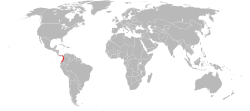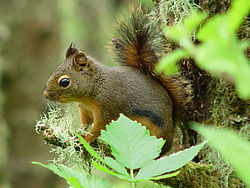| Western dwarf squirrel | |
|---|---|
| Scientific classification | |
| Kingdom: | Animalia |
| Phylum: | Chordata |
| Class: | Mammalia |
| Order: | Rodentia |
| Family: | Sciuridae |
| Genus: | Microsciurus |
| Species: | M. mimulus |
| Binomial name | |
| Microsciurus mimulus (Thomas, 1898) | |
| Subspecies [2] | |
| |
 | |
| Western dwarf squirrel range | |
The western dwarf squirrel (Microsciurus mimulus) is a small tree squirrel in the genus Microsciurus and tribe Sciurini found in Colombia, Ecuador, and Panama.
All of the subspecies of M. mimulus have been recognized as distinct species in recent studies, although this is not yet universally accepted. [3] The table below lists the three subspecies of Microsciurus mimulus, along with any synonyms associated with each subspecies: [2]
| Subspecies | Authority | Synonyms |
|---|---|---|
| M. m. mimulus | Thomas (1898) | none |
| M. m. boquetensis | Nelson (1903) | none |
| M. m. isthmius | Nelson (1899) | palmeri, vivatus |



